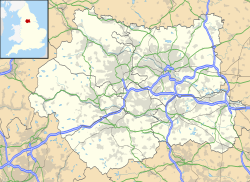Lagentium
| Lagentium | |
|---|---|

Modern tile mosaic illustrating Castleford's Roman history
|
|
| Alternative name(s) | Legiolum |
| Founded | c. 74 AD |
| Abandoned | 180 AD |
| Province | Britannia |
| — Wood and earth structure — | |
| Built | c. 70 AD |
| Coordinates | 53°43′34″N 1°21′22″W / 53.726°N 1.356°W |
| Town | Castleford |
| County | West Yorkshire |
| State | England |
| Country | England |
| UK-OSNG reference | SE4225 |
Lagentium or Legiolum was the Roman name for the fort and surrounding civilian settlement which was built around the year 74 by the Roman Empire. The English town of Castleford, West Yorkshire, is now built on what was the fort.
Around this time, the Romans defeated the Brigantes, a peaceful, farming people. The Romans named this new settlement Lagentium. They built a turf and timber fort sometime in the early 70s to guard the river crossings and the vital road to the north. The fort was built on either a natural ridge or a man-made mound, we are not certain. The Roman engineers chose Lagentium for its strongly strategic position. The mound offered a strong and clear vantage point, and the river offered a source of water and food. The low crossing point also had the advantage that both sides of the river could be farmed on. So a fort was built on top of a Brigantian settlement. Over the sixty years since the fort was built, permanent shops and gardens were built, and traders began to arrive.
The fort was garrisoned for 24 years by the Roman army, to keep the Brigantes under control. The Romans simply believed that the Brigantes were 'barbarians', but peace was eventually established and the troops were moved to the north. The Brigantes were not the most advanced of British Tribes, but the few Brigantes that did accept Roman law were allowed to experience greatly enhanced living conditions, under the watchful eye of the Romans.
Around 43, a road known as Ermine Street ran from the south to the north, but the Romans had to cross the Humber estuary to get to the other side of the road. The estuary was two miles wide, and the river had raging currents, and was subject to strong winds, making any crossing very difficult. Also, the Romans were not keen sailors, so this route north was not appropriate. So the Romans built another road, locally known as Roman Ridge and often considered a branch of Dere Street or Watling Street, with numerous forts strategically positioned along it. Lagentium, along with what is now Littleborough, Bawtry, Tadcaster and Doncaster, was one of these forts.
The fort built in Castleford shared many of the luxuries of any Roman settlement. In the vicus (a settlement just outside the fort) there were temples, houses, shops, alehouses(public house), public bathhouses and brothels. Many other improvements were made to Lagentium, including straight metalled roads, rectangular stone buildings with tiled roofs and glazed windows; the houses had drains and sometimes central heating.
...
Wikipedia

